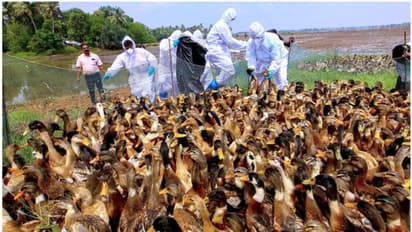Kerala: Over 20,000 ducks culled in Alappuzha over H5N1 bird flu

Synopsis
In Alappuzha, more than 20,000 ducks were culled in the bird flu-affected panchayats of Edathua and Cheruthana. Eight Rapid Response Teams (RRTs) formed by the Animal Husbandry Department completed the culling process by evening. The carcasses were disposed of by burning them using a mixture of kerosene and sugar.
Alappuzha: Following the outbreak of H5N1 bird flu, more than 20,000 ducks were culled in the panchayats of Edathua and Cheruthana in Alappuzha on Friday (April 19). This decision was made during a meeting chaired by the District Collector, which included departmental officials and representatives from the affected panchayats. The measures aim to contain the spread of the disease and safeguard public health.
Officials from the Animal Husbandry Department reported that eight Rapid Response Teams (RRTs) were established under the department, and they completed the culling operation by evening. The carcasses were disposed of by burning them using a mixture of kerosene and sugar, as stated by the officials.
The district administration has declared the areas in the two panchayats as flu-affected and banned the transportation of birds from there to other places in the district. The sale of eggs, feeds, and manure of ducks, chickens and other birds has been banned for two weeks.
Ducks in these areas have been experiencing a significant number of deaths over the past week, prompting authorities to take swift action. Samples taken from affected ducks were sent to a laboratory in Bhopal for testing, and all samples tested positive for the disease.
What is the H5N1 virus?
H5N1 is a type of influenza virus that primarily affects birds, particularly poultry such as chickens and ducks. It is highly pathogenic, meaning it can cause severe illness and high mortality rates in infected birds. H5N1 is one of several subtypes of the influenza A virus, and it can also infect other animals and occasionally humans.
Direct contact with infected birds, their droppings, or contaminated surfaces are ways of spreading the virus. The infection has not yet been easily transmitted to humans, but when it does, the fatality rate can be as high as 60 percent.
Stay updated with the Breaking News Today and Latest News from across India and around the world. Get real-time updates, in-depth analysis, and comprehensive coverage of India News, World News, Indian Defence News, Kerala News, and Karnataka News. From politics to current affairs, follow every major story as it unfolds. Download the Asianet News Official App to stay informed anytime, anywhere.